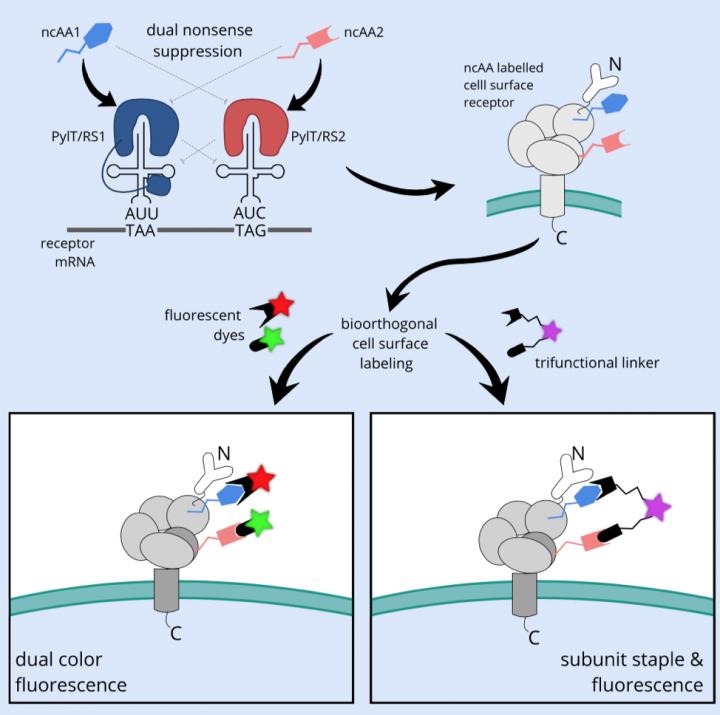Illuminating cell surface receptors

Site-specific incorporation of two noncanonical amino acids for two-color bioorthogonal labeling and crosslinking of proteins on live mammalian cells Credit: Simon Elsässer
Birthe Meineke and Johannes Heimgärtner have jointly developed a method in Simon Elsässer's lab at Science For Life Laboratory Stockholm to label and image receptors on live cells with two different colors.
Unlike existing live-cell microscopy methods, which typically rely on sizeable fluorescent proteins fused to the receptor, here only two amino acids in the receptor of interest are exchanged for noncanonical amino acids.
These two synthetic building blocks act as chemical handles, each compatible with a different fluorescent dye, using so-called bioorthogonal chemistry.
The method allows for two differently colored dyes to be installed on live cells in almost any position of the receptor. Hence, fluorescent assays can be developed that not only read out the localization of the receptor, but also report on conformational changes involved in sensing the environment and transducing extracellular signals to the cells' interior.
Many receptors, such as the large family of G-protein coupled receptors, are important drug targets. Mechanistic insight into the action of drugs on those receptors has so far predominantly been collected on purified receptors in an in vitro environment.
The new method, successfully demonstrated by the team on a G-protein coupled receptor and a Notch receptor, expands the possibilities to study natural behavior and pharmacology of receptors in their native setting in the membrane of live cells.
###
The study was funded by Karolinska Institutet/Science for Life Laboratory SFO in Molecular Biosciences, Vetenskapsrådet (2015-04815), Ming Wai Lau Center for Reparative Medicine, Ragnar Söderbergs Stiftelse, Knut och Alice Wallenbergs Stiftelse (2017.0276)
Media Contact
More Information:
http://dx.doi.org/10.1016/j.celrep.2020.107811All latest news from the category: Life Sciences and Chemistry
Articles and reports from the Life Sciences and chemistry area deal with applied and basic research into modern biology, chemistry and human medicine.
Valuable information can be found on a range of life sciences fields including bacteriology, biochemistry, bionics, bioinformatics, biophysics, biotechnology, genetics, geobotany, human biology, marine biology, microbiology, molecular biology, cellular biology, zoology, bioinorganic chemistry, microchemistry and environmental chemistry.
Newest articles

Pinpointing hydrogen isotopes in titanium hydride nanofilms
Although it is the smallest and lightest atom, hydrogen can have a big impact by infiltrating other materials and affecting their properties, such as superconductivity and metal-insulator-transitions. Now, researchers from…

A new way of entangling light and sound
For a wide variety of emerging quantum technologies, such as secure quantum communications and quantum computing, quantum entanglement is a prerequisite. Scientists at the Max-Planck-Institute for the Science of Light…

Telescope for NASA’s Roman Mission complete, delivered to Goddard
NASA’s Nancy Grace Roman Space Telescope is one giant step closer to unlocking the mysteries of the universe. The mission has now received its final major delivery: the Optical Telescope…



